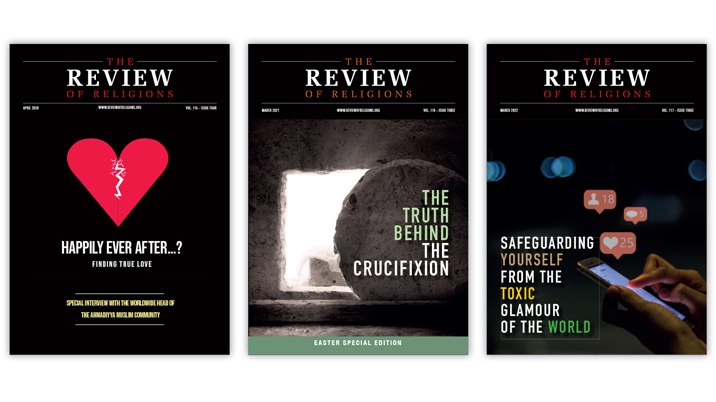
Hazrat Mirza Ghulam Ahmad, the magazine’s founder, had little funding to support his vision and his ‘writers’ were people who were knowledgeable, but without any experience in publishing. The management and editorial teams had largely never travelled to the US or Europe, which was the target audience. But it was because they were punching far above their weight that leading thinkers of the time, Leo Tolstoy amongst others, started to take notice and commend the magazine. The content was pioneering and their drive and determination unmatched.
Around 110 years later, we faced modern challenges. We had no website, no social media presence and no audio or video content. The print edition was largely still black and white and our reach was limited to those print subscribers. We were hidden from the digital world, which meant we weren’t reaching our full potential.
A strategic re-launch was required, but we had limited resources (we are published by the Ahmadiyya Muslim Community, a registered charity) and limited staff to achieve this. We had to adopt the strategy used by the pioneers of the magazine, who regularly punched hugely above their weight.
Our first move was to create firm modern foundations. If you don’t peg your tent strongly to the ground, it will fall down. In 2010, we launched The Review of Religions on several platforms – we started our website, established a presence on Twitter, Instagram and Facebook, created our first series of videos, and began holding an annual exhibition. These were the humble beginnings of a five branched multi-platform base. Each platform was basic, but it rooted the foundation for a contemporary structure.
Print remains the anchor
We decided to make our print edition a more premium offering. For over 100 years, The Review of Religions was published in black and white. In 2010, we went full colour, changed to a higher-quality printer and later added perfect binding. The management committee decided to maintain the annual subscription at £15 alongside a new student subscription rate of £5. Subscribers were overjoyed at receiving a vibrant look and feel product for the existing price. Subscriptions increased and younger audiences began to engage with print, often for the first time, availing themselves of the new student rate.
Re-branding – a modern design
We needed to update our design and logo. With our designer, we formed some draft logo designs and then opened the process up to our readers. We told them that we had narrowed our logo designs down to two options and that we would run each option for six months on our front cover. Readers would decide which logo we settled for. At the end of the year, we selected the logo with the most positive public feedback.
What we didn’t envisage was how passionately our readers would respond. We had announced the need for reader feedback across platforms, and in response, people replied with enthusiastic mini-essays and well thought out arguments for which logo should be chosen. The engagement with this re-branding process was massive. As part of the design journey, we were able to garner greater reader loyalty.
Team building – key to our success
The management put their trust in youth. I was 27 when I was appointed editor and many of the team were younger than me and were appointed in key roles. These digital natives brought an acute understanding of the digital landscape. As experience is vital, we also had some seasoned staff, but were particular to include those mature heads who have ‘young minds’; ie. they supported and guided the youth, rather than feel threatened by their dynamism.
Women made up 60% or more of our wider staff and continue to hold key positions. Across our worldwide teams, we have members from Ghana, Nigeria, Germany, France, the USA and Canada to name a few. This diversity was and is extremely important as they bring fresh ideas and can advise on sensitivities that otherwise we may be unaware of. This has a direct impact on the images we use and the language we adopt.
Feedback driven content at the centre
We wanted to ensure ‘content is king’ remained at the core, and asked the public for feedback on topics. Good feedback led to good content. We developed a number of sections like World Religions, Archaeology, Science, Women’s Issues and so on, each with their own section editors. The topics we featured surprised many readers. A front cover read ‘Cannabis – an Unstoppable War?’ We had a main feature in another edition on mental health, and tackled head on the issues around terrorism and extremism, and women’s rights in Islam. Readers did not only want theological pieces, but also personal stories and lighter reads. We pivoted part of our content strategy to cater for this across all our platforms and the response was overwhelmingly encouraging, proving how much our content mattered in the daily lives of our readers.
We did not however only cover ‘trending topics’. We often went against trends and became thought-leaders. In the early 2010s, we published a series of speeches by Hazrat Mirza Masroor Ahmad, world head of the Ahmadiyya Muslim Community. He argued we were heading towards world war three and potentially a nuclear war, based on economic, social and political upheavals. At the time, some poured scorn on such views as fanciful. A decade leader, the potential for a world and nuclear war is now commonly voiced across world media. Sometimes, you have to stick your neck out and lead with opinions, rather than just follow trends.
Using our website effectively
Our website started off with an exceedingly basic design. It served simply to upload print edition articles after a length of time and was clunky. We decided to focus on in-house development rather than using external companies and gradually the website became more dynamic and visually appealing. A seminal year was when we decided we would upload exclusive online content featuring shorter articles on trending topics in between monthly editions. In the beginning, we barely managed to upload more than one exclusive online article a month as we struggled to get quality articles. Gradually, however, this increased as the team grew in both numbers and experience and now we often have several new online articles in a day.
The reality of the world we live in is that you have to interest not just the reader, but also the Google algorithm, to get your articles higher ranked and visible to readers. As we can’t compete with bigger magazines in online marketing budgets, we trained staff instead in the use of SEO and journalistic skills and gave them access to analytics. We experimented with titles, intro texts, sub headings and content. What this meant was that with a minimal marketing budget, some of our articles reached the top ranked Google search items. If you search ‘Religious Trends in Japan’ or ‘Religious Trends in Germany’, The Review of Religions articles appear one of the highest ranked, even above Britannica, and the German and Japanese government websites! High quality content with the effective use of SEO and analytics enabled us to, sometimes, compete with brands vastly larger than ours.
Videos to reach millions, with limited resources
We entrusted youth in their early twenties with no prior experience but with huge potential to launch our YouTube channel. We started with basic videos, a series called ‘what does x’ [death, spirituality etc] mean to you? After around a dozen videos and establishing consistency, we produced, ‘I am a Muslim – Ask me Anything?’ This was a social experiment across six US states where I used a team member who had the longest beard and a whiteboard to engage with the US public on the toughest questions relating to Islam! Our cameraman was using his personal camera, and I was using my iPhone 6 for all side angle shots. Almost seven million views later, the video has been a resounding success. We had t-shirts made with the title of the video, and our magazine logo on one side. After the dreadful terrorist attacks in Westminster, the youth of the Ahmadiyya Muslim Community, wearing our t-shirts, came out in big numbers to show their support for the victims and to demonstrate that the atrocities had nothing to do with Islam. Muslim youth in other countries adopted our same slogan. These campaigns and pictures of people wearing our t-shirts were splashed across Daily Mail, CNN, BBC, The Independent, Global News Canada to name a few. Our video, using basic equipment, was able to garner influence far beyond just YouTube, reaching potentially tens of millions.
Language editions pave new grounds
From 2016 to 2018, we focused on launching foreign language editions, German from Frankfurt, Spanish launched from Guatemala, and French from Trie-Château in northern France. Each started using not just translations from the English edition, but also curating their own content based on the needs of their respective countries. The potential Spanish speaking audience worldwide exceeds 450 million. However, due to various factors, the print edition was not predicted to reach huge audiences in South America. Our Spanish edition team decided to, in parallel, focus on video-first and a new video podcast became one of the central content productions. Facebook is massive in South America, used far more than any other social media platform. We uploaded these podcasts to Facebook as well as YouTube, and invested small amounts into Facebook advertising. The content was engaging and relevant. Christianity remains a huge influence in South America, and so when our podcasts spoke on the views of ‘Jesus in Islam’, the result was that the show was seen by anything between 100k and 600k people and received thousands of comments an episode. Now, due to Facebook’s recent problems, we are trying to pivot away from using Facebook in general. Regardless, at very low cost, video brought huge success to The Review of Religions En Español brand in Latin America.
Africa – a golden opportunity
In Ghana and Nigeria, we created a distribution network, unique in the magazine industry. Internet and mobiles are used by everyone and all facilities and technologies are readily available there, but data remains expensive and so the print edition retains importance. We switched to DHL, who despite being quite expensive, are the only distributors I am aware of who deliver door to door from the UK to Ghana and Nigeria whilst others distribute to the airports only, and then partner with national postal services, which you can neither track nor rely on.
In Ghana, our editions reach our national coordinator at our office in Accra who then sends them on buses and cars each month to 32 designated zones. This is a pre-arranged and organised network and editions are delivered safely and in timely fashion. In each zone, our local reps collect the editions and sell them at local outlets, pop up stalls and so on. The total time from receiving the editions in Accra from London to getting into the hands of customers across Ghana, is one and a half weeks. After this new system was instigated, it led to a 50% increase in subscriptions in just three months and there is growth in annual subscriptions as opposed to just single copy sales. In future, we are looking to introduce audio and video as a major new format for delivering our content, using local voices and presenters as these formats are vastly popular in Ghana and Nigeria.
Exhibitions and events also formed an important part of our strategy.
Where does our future lie? We hope to continue to grow all our platforms, launch a digital edition by next year, consolidate our language editions and introduce audio as a main branch. We will continue doing so using the minimum of resources whilst seeking maximum results.
This article was first published in InPublishing magazine. If you would like to be added to the free mailing list to receive the magazine, please register here.












